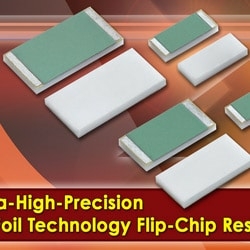source: Vishay VPG news
Latest from VPG is the Vishay Foil Resistors FRFC Series, a new family of ultra-high-precision flip chip resistors based on the market-leading Z1 Foil Technology. The FRFC Series delivers remarkable load life stability of 50ppm, better withstanding to higher temperatures, and better moisture resistance than previous-generation foil resistors. Compared with surface-mount chips with wraparound terminations, the flip chip configuration of the FRFC Series provides PCB space savings of more than 35%.
The FRFC Series owes its high-performance characteristics to a resistive element based on Z1 Foil Technology, a solid alloy that is matched to the ceramic substrate with polyimide bonding to enable a uniform thickness of the bond line, superior adhesion strength, and improved resistance to moisture. Virtually insensitive to destabilizing factors, the FRFC Series features a temperature coefficient of resistance (TCR) or ± 0.2 ppm/C (-55°C to +125C, +25C ref), ESD immunity to 25kV or more, and noise-free operation. Its power rating is 750mW at +70°C, a 25% improvement over the VFCP Series, which is already a superior product in the high-precision resistors industry. The FRFC Series flip chip resistors are offered in the 0805, 1206, 1506, 2010, and 2512 case sizes, with power TCR (ΔR due to self-heating) of 5ppm at rated power and tight tolerances to ±0.01%.
“The FRFC Series devices provide designers with the most stable resistors available today — allowing them to achieve new benchmark levels in performance,” said Jacky Acoca, director of sales and marketing, Vishay Foil Resistors. “In addition to saving on board space, the devices’ flip chip terminations increase reliability by providing better strain relief to eliminate cracked substrates and board delamination.”
The FRFC Series flip chip resistors are optimized for a wide range of high-precision industrial, telecommunications, medical, and laboratory applications, including bridge networks, gyro navigational controls, pressure sensors, standards and decade boxes, process controls, weighing systems, electron beams, and automatic test equipment.
The new resistors offer a resistance range from 5ohm to 125kohm with any conceivable ohmic value within this range — out to six digits – available with no additional cost or lead time effect. They feature a rise time of 1 ns with effectively no ringing; a thermal stabilization time of <1s (within 10ppm of steady state value); current noise of 0.01μVrms/V of applied voltage (<-40dB); and a voltage coefficient of <0.1ppm/V. The RoHS-compliant FRFC Series resistors offer a non-inductive (<0.08 μH), non-capacitive design and are available in matched sets on request, says the company.































